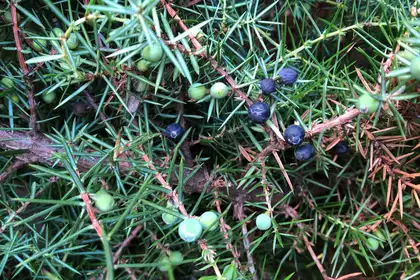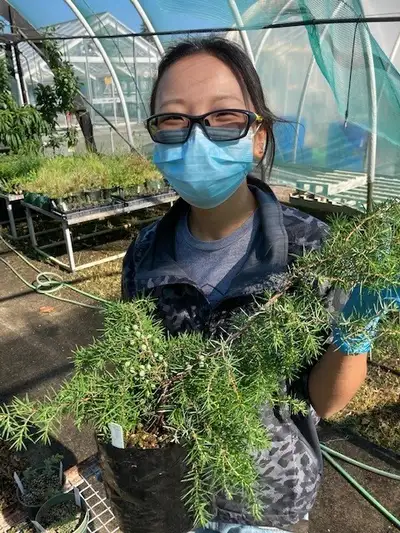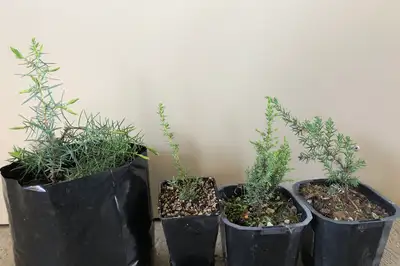
Juniperus communis berries at varying stages of ripeness. The berries are green initially, then darken over time and are ripe after three years.
As supply chains have become restricted, and the price of imported berries has kept rising, the opportunity for New Zealand-grown berries, for which provenance and quality management can be assured, seems – shall we say – ripe.
Working in collaboration with Juno Gin’s Dave and Jo James, and funded by the Massey University-Bashford Nicholls Trust Pivot Award, Massey researchers are working on a range of projects aimed at advancing a juniper berry industry for New Zealand.
Massey University Business Development Manager and Project Coordinator Eve Kawana-Brown says, “We have significantly more ‘ground to cover’ to grow our understandings of New Zealand-grown Juniperus communis’ potential for the local food and beverage industry, and how best to breed, grow and crop for such an industry. However, we are now making good progress.”
The project work builds on The Great NZ Juniper Hunt, and work that was completed via a Juniper Genetics Study, which Massey University and Begin Distilling (Juno Gin) collaborated together on from 2017-2020, with support from The Agricultural and Marketing Research and Development Trust’s (AGMARDT) Agri Innovation funding, and Venture Taranaki.
The project brings together the combined experience and expertise of Massey researchers from a range of disciplines to work together in complementary ways to progress the research needed to support the evolution of a juniper berry industry for New Zealand.
A significant focus of the research is to further examine New Zealand-grown juniper berries to determine if different terroir might lead to distinctive sensory profiles in New Zealand-made gins. Another focus is on growing an understanding of the implications for plant identification, collection, selection, propagation, growing and harvesting, in both the North and South Islands of New Zealand.
Professor Joanne Hort, Fonterra-Riddet Chair of Consumer and Sensory in the Food Experience and Sensory Testing (FEAST) Lab at Massey’s School of Food and Advanced Technology, is leading work to analyse the attributes of gins made from NZ-grown juniper berries. Dr David Popovich from the School of Food and Advanced Technology is studying their volatiles profile as well as drying and storage protocols. Dr Svetla Sofkova and postgraduate student/technician Su Liu from the School of Agriculture and Environment are learning more about the propagation and reproductive biology of juniper plants, and Dr Vaughan Symonds from the School of Natural Sciences is focused on analysing genetic diversity within Juniperus communis.
The researchers have been continuing to experiment with propagation techniques and currently have 482 Juniperus communis seedlings at varying stages of juvenile development.

Postgraduate student/technician Su Liu holding a juniper plant.
Early research completed by Massey genetics researchers has established that this New Zealand stockholding appears to be fairly genetically diverse, which is important when embarking on growing healthy and resilient populations of any plant variety. Ongoing work to develop genetic markers will help with studying diversity in the New Zealand stockholdings relative to global collections.
Because producing plants from seeds or from imported living plant materials poses significant challenges, the researchers’ plan is to progress to trialing in-field plantings from these New Zealand-derived plants.
Early indications are that the New Zealand berries may exhibit unique volatile oil attributes. Juno Gin’s Dave James says that ‘terroir effects’ in New Zealand for J. communis could enhance the value of the berries, and therefore New Zealand-made product in international markets.
However, it seems there are a mere handful of fruiting trees in New Zealand. The researchers have only received sufficient quantities from two sources for preliminary berry volatiles analysis to date.
The team are working with four owners of berry-bearing trees to obtain berry samples for further analysis this year – importantly to understand whether the volatiles profiles from New Zealand-grown berries are actually favourable for gin-making.
If you know of any trees with ripe berries on them Massey’s researchers would love to hear from you. Please contact Eve Kawana-Brown at E.Kawana-Brown@massey.ac.nz.

Three variants of Juniperus communis. The larger leafed variant on the left is of most interest to the research group.
Additional Information
The NZ Juniper project builds on a collaboration between Begin Distilling (Juno Gin), plant nurseries and tree growers, and a study completed by Massey University (Dec 2017 – Feb 2018) on the feasibility of developing a juniper (Juniperus communis) berry production industry in New Zealand.
Their public web project (The Great NZ Juniper Hunt), was launched in Feb 2019, along with a significant publicity/media campaign, and contact with all New Zealand botanic gardens, 40 nurseries and over 30 garden clubs and horticulture societies around the country.
The project has well canvassed the country for J. communis stockholdings, and has made progress in locating and identifying J. communis plants across New Zealand. Ninety-eight samples have been collected from 146 potential Junipers, with 47 trees confirmed as likely J. communis samples as at end of June 2021.
While only 47 likely confirmed J. communis trees have been revealed via this project to date, genetic testing of 24 of these samples has revealed encouraging genetic variation and breeding potential.
Only 20 (small) berry samples were able to be collected and dried, from 32 observably female (or potentially monoecious (dual-gendered)) plants, not necessarily all from Juniperus communis.
Due to quantities and condition of berries needed for testing, the project was only able to comparatively test volatile profiles of two New Zealand berry samples to compare with purchased berries – i.e. three samples each of ‘generic Northern Hemisphere-sourced’ berries from two different commercial suppliers.
Significant differences seem to exist in the oil composition of berry samples sourced from New Zealand. The New Zealand-grown juniper berries sampled would appear to fit within the outlying 10 per cent of J.communis studied globally to date. However, further volatiles testing is needed to verify this finding, as sample sizes were very small and post-harvest storage of the berries was not monitored.